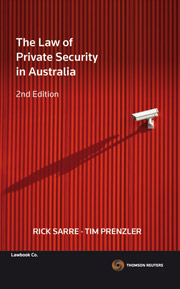
The Law of Private Security in Australia Second Edition - Book
|
Book $190.00 RRP |
Date: 08/07/2009 Code: 9780455226835 Lawbook Co., AUSTRALIA |
 The Law of Private Security in Australia Second Edition - Book
Price: $190.00
|
Available Formats
| Format | Title | Date | Code | Price | |
|---|---|---|---|---|---|
| Book | The Law of Private Security in Australia Second Edition - Book | 08/07/2009 | 9780455226835 | $190.00 |
Add to cart
 The Law of Private Security in Australia Second Edition - Book
Price: $190.00
|
Description
Rapid growth and burgeoning diversification within the private security industries have extensively increased interaction between security operators and the public. This increased exposure, together with a number of highly publicised incidents, has brought about a heightened focus on levels of industry professionalism and accountability (including public concerns surrounding personal freedoms), and more burdensome licensing and regulatory controls upon both security companies and individuals. Importantly, it has also prompted security staff to be mindful of their own vulnerability in a vocation where personal legal immunities are rare.
The only work of its kind in this country, The Law of Private Security in Australia, 2nd Edition is an indispensable guide to the rights and responsibilities of private security personnel and their employers.
The authors utilise examples from the industry, underscored by case law, State and federal laws and regulations, industry codes of practice, and ethical protocols. They clearly identify the sources and scope of private security powers and the liabilities impinging upon them. In each scenario, a range of potential actions – desirable and undesirable – is given, as well as the legal consequences that spring from these actions for both employers and employees. The law covered is also of great relevance to police officers, as many of the legal principles that apply to private personnel emanate from the laws that empower and restrict public police.
With its clear explanations of legal concepts by authors with years of experience in teaching lawyers and non-lawyers, The Law of Private Security in Australia, 2nd Edition is essential reading for every security company, security operator and private policing agency.
Editorial Reviews
From: Ethos, December 2009
Reviewed by Christopher Ryan, Silk Chambers
Table of Contents
Table of Contents
Introduction
1. Measuring the Private Security Industry in Australia
2. The Law in Context
3. Legal Sources of Private Security Powers
4. Apprehension, Arrest and Assault
5. False Imprisonment and Other Matters Incidental to Apprehension
6. The Protection of Privacy
7. Electronic Surveillance and Access to Private Information
8. Commercial Liabilities for Private Security
9. Relationships between Public and Private Security Personnel and Issues of Accountability
 Criminal Law
Criminal Law